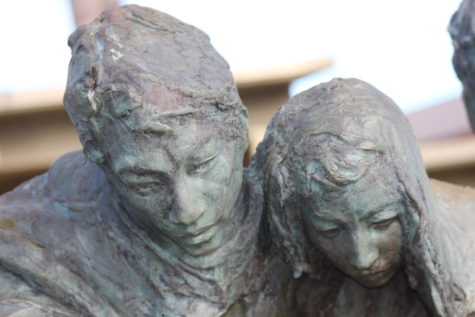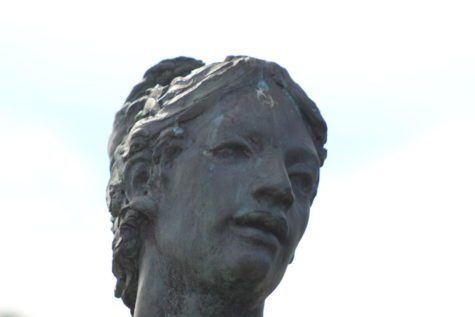‘Striving for Excellence’ Son of Creator Gives Insight into Radford Statue
(Photo Credit JEVRON FREEMAN) Jan Fisher preferred to use his hands over tools when sculpting meaning that his fingerprints can be found all over his works. “My father’s fingerprints are immortalized in bronze,” stated Jonny Fisher.
May 11, 2022
Frozen bronze eyes gaze over the herds of students, whooping and laughing, as they amble down the halls; none of them return the stare, not even a glance. Such a magnificent thing is often ignored by youths who are too focused on minuscule issues that seem to blow up their social lives. If one were to pay close attention though, they would find that this statue is not quite as alone as it seems. Registrar Clerk and Hawaiian language teacher, Rick Salado, known to many students as Uncle Ric, keeps careful watch over the statue and can be found in its vicinity throughout the day. It is Uncle Ric who carries and spreads the legacy of this statue. When he noticed curious students lingering around it, he excitedly explained its history as they eagerly listened, thus beginning their journey and inquiry into its existence.
This masterful work of art, known to many students as the Radford Statue, is titled “Striving for Excellence” and has inhabited the campus since its commission by the State Foundation on Culture and the Arts’ “Art in Public Places” program in 2001. Jan Fisher, the sculptor responsible for many of the statues in Waikiki, was also the creator behind the Radford Statue. His son, Jonathan “Jonny” Fisher, explained the meaning and creation of the statue.
“My father loved art since he was a kid. He really liked oil paintings and ceramics,” Fisher said. “He especially loved the human form and he felt people were works of art that God created. So he wanted to make all of his sculptures anatomically correct.”
To make a bronze statue such as this one, it must first be sculpted to scale out of clay. Jan Fisher used his own concoction of clay which was made by mixing clay, paraffin wax, and motor oil in a 55 gallon drum over a burner with his son’s assistance. This ensured that the clay stayed warm and workable when sculpting and solidified when it cooled down. After the clay model was complete, a rubber mold was made around the clay statue and cut off in panels. These panels would then be sent to a foundry where a plaster cast would be assembled and poured with bronze, one of few metals that does not rust.
“It was like making witches brew,” said Jonny Fisher.
Jan Fisher built and completed the Radford statue between 1999 and 2000. Now, over 21 years later the Radford student body is still honoring, and acknowledging the amazing life and career of the creator behind the illustrious statue. Jan Fisher started the tedious process of building and creating the statue with one idea in mind: diversity in unity.
He created the Radford statue as an embodiment of Hawaii, which has long been a cultural melting pot. It portrays diversity through representation with a Hawaiian woman representing Hawaiian culture. The statue also features a Caucasian woman and an African American man and a hapa (mixed) man wrestling.
“The Hawaiian lady was supposed to be holding an ipu,” Fisher stated, “If you look at her hands it looks like that’s what she is doing.” Jan Fisher used these characters to illustrate the intended meaning and message behind this piece.
When Jonny Fisher was 7, his family moved away from Laie, Oahu and to the Big Island of Hawaii where they currently reside. The Fisher brothers often helped their father on commissions with some of the smaller tasks such as mixing the clay. Jonny Fisher’s brother, James “Kimo” Fisher even modeled for one of the wrestlers in the Radford Statue.
Jonny Fisher was between 12-14 during the statue’s commission. He said, “I was pretty bummed out at the time. I wanted to go surfing and hang with friends but instead, I had to help him out… but now we look back and really cherish those experiences.”
Jan Fisher started his professional artistic career as a professor of ceramics and sculpture at Brigham Young University in Laie, Hawaii. He had a fondness for oil painting and ceramics since he was young and was also the first in his family to attend college. He wanted to make his father proud and further develop his sculpting skills, mastering arguably the hardest medium in art.
While Jan was meticulously creating the statue he was commissioned to do for Radford, he was also working on The Princess Kaʻiulani Statue in Waikiki concurrently. Jan built both sculptures simultaneously because of his very specific clay and sculpting process.
When sculpting historical figures, such as Princess Kaʻiulani, “he [Jan Fisher] would want to do them justice, he would want to embody who they were,” said Jonny Fisher.
Jan Fisher’s first large-scale, professional statue was the Sugar Mill Monument in Kauai though one of his most renowned and recognizable works is the Duke Kahanamoku statue, which has stood in Kuhio Beach Park, Waikiki since 1990.
This specific piece was completed in one month, just in time for what would have been Duke Kahanamoku’s 100th birthday. For Fisher, sculpting real figures was a spiritual endeavor. He often prayed for guidance and would ask for personal items, such as Duke Kahanamoku’s surfboard, in order to get a feel for who they were as a person and most accurately represent them.
“When he did Duke Kahanamoku’s face he said it all came at once and he sculpted it very quickly. And after it was done he didn’t touch it again,” said Jonny Fisher.
Before the statue was cast, Duke Kahanamoku’s wife came to Fisher’s studio to see the completed clay model. She drew a line on each leg with her fingernail because the statue’s shorts were too long and when Fisher shortened them, he left the lines which are still visible on the statue.
When Kahanamoku’s wife first saw the statue, she gasped and exclaimed “it’s him,” according to Jonny Fisher.
The documentary “Water Man,” which was directed by Jan Fisher’s nephew, Isaac Halasima, features the legacy of Duke Kahanamoku, an Olympic swimmer who brought surfing and aloha to the world. It was released on April 1st of this year, debuting at the Bishop Museum, and has already won numerous awards. At the end of the film, there is a tribute to Jan Fisher.
Jonny Fisher described just how much of an influential figure his father is in public art. He said, “Whenever I go back and I walk around in the streets and the next thing you know you see one of my dad’s sculptures and you think, ‘Wow! my dad did that.’”







